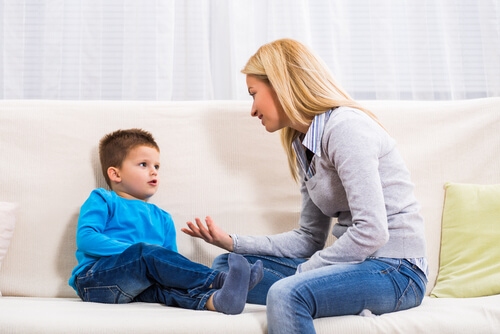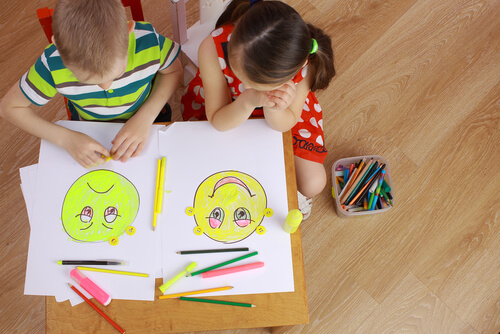Dealing with Conflicts without Punishments


Reviewed and approved by the psychologist María Alejandra Castro Arbeláez
Below you’ll find tips for parents on how to deal with conflicts without punishments.
It’s not only children who get overwhelmed by their emotions. Parents do too.
In moments of tension parents can lose their temper and often end up punishing their children, without realizing that this reaction reinforces negative behavior in children.
To learn to deal with conflicts without punishments, we need to look at how educators cultivate emotional intelligence.
We should learn strategies on how to win different battles when facing aggressive and stressful situations. By doing this we’ll be able to deal with conflicts without punishment.
It’s clear that punishments don’t have any long-term learning benefits. This is because punishments don’t change the causes of inappropriate behavior.
Far from improving the situation, it actually generates negative emotions in the child towards those who apply these punishments. That’s why we need to learn other ways to show children how to deal with situations better.
How to do it? That’s the question. A good strategy is to work on two fronts at the same time. One is reflection, and the other intervention.
But before you do that, you need to cultivate patience, empathy and creativity. Educating your child requires you to deprogram and to stay calm at all times.
That will make a big difference, as you’ll be able to act calmly, instead of overreacting and imposing a punishment on your children.

Dealing with conflicts without punishments
To learn to manage conflicts without resorting to punishment, you first need to decide if your child is really behaving badly. It’s good to consider in what way their behavior is inadequate. We should then reflect on what caused that behavior and what is behind it.
We need to keep in mind that very often there are other things behind inappropriate child behavior. Often with more information and the ability to express that information, a child would’ve been able to act otherwise.
When you’re in the heat of a conflict that has created anger or aggression, it’s best not to act under the influence of those emotions.
If the conflict is between two siblings – something that is very frequent – the first thing you have to do is separate them and protect the attacked person from harm.
However, the most important thing is not to add fuel to the fire, and avoid worsening the situation.
Act calmly
In the moment of conflict, the best thing you can do is just stay with them quietly and calmly, until they calm down. You can hug him if he lets you.
Try to calm him down with some of your words, without looking for who was to blame or what happened. When he’s calm, you can start talking to them.
“If you foster love in your family, your children will go out of their way to make others happy.”
–Rosa Jove, psychologist specialized in child clinical psychology–
Then, very calmly, you should ask your child to describe what happened. When he does, listen to him without correcting or judging him.
If they aren’t able to do it because they’re still too small or because of lack of language resources, you can help him describe the facts, but always with moderate and conciliatory language.
The central point of this conversation should be that the child will be able to identify the emotion that led him to behave inadequately or violently, and what he felt after behaving like that.
Recognizing emotion is important, as well as not inhibiting it. The idea is that you should teach him to identify his emotions and manage them properly.
They should be told that it’s normal to feel angry, but it’s not okay to react by hitting another child, for example.

Controlling emotions is a key point
Teach him to recognize and validate his emotions. They’re all part of our human nature, and so judging them as good or bad invites guilt and prevents them from being properly channeled.
You can also explain how you felt about their bad behavior. Use the right words and call each emotion by its name. I felt frustrated, upset, sad, for example.
Avoid saying phrases like “you made me feel.” When you say that you felt frustrated, you show that you’re taking charge of your emotions, and not burdening your child with them.
You can help him empathize through everyday examples that connect him with a similar emotion. To achieve this you can refer to movies, cartoons, stories, or some incident at school.
You need to remind him of the points you’ve discussed and, if necessary, talk about them again. Do this as many times as necessary. In doing so, avoid annoying phrases such as “how many times have I told you…”
Children need less punishment and more words. Science has shown that our brain has many difficulties processing the word “no.”
You’re much more likely to be heard when you structure your sentences positively rather than negatively.
Below you’ll find tips for parents on how to deal with conflicts without punishments.
It’s not only children who get overwhelmed by their emotions. Parents do too.
In moments of tension parents can lose their temper and often end up punishing their children, without realizing that this reaction reinforces negative behavior in children.
To learn to deal with conflicts without punishments, we need to look at how educators cultivate emotional intelligence.
We should learn strategies on how to win different battles when facing aggressive and stressful situations. By doing this we’ll be able to deal with conflicts without punishment.
It’s clear that punishments don’t have any long-term learning benefits. This is because punishments don’t change the causes of inappropriate behavior.
Far from improving the situation, it actually generates negative emotions in the child towards those who apply these punishments. That’s why we need to learn other ways to show children how to deal with situations better.
How to do it? That’s the question. A good strategy is to work on two fronts at the same time. One is reflection, and the other intervention.
But before you do that, you need to cultivate patience, empathy and creativity. Educating your child requires you to deprogram and to stay calm at all times.
That will make a big difference, as you’ll be able to act calmly, instead of overreacting and imposing a punishment on your children.

Dealing with conflicts without punishments
To learn to manage conflicts without resorting to punishment, you first need to decide if your child is really behaving badly. It’s good to consider in what way their behavior is inadequate. We should then reflect on what caused that behavior and what is behind it.
We need to keep in mind that very often there are other things behind inappropriate child behavior. Often with more information and the ability to express that information, a child would’ve been able to act otherwise.
When you’re in the heat of a conflict that has created anger or aggression, it’s best not to act under the influence of those emotions.
If the conflict is between two siblings – something that is very frequent – the first thing you have to do is separate them and protect the attacked person from harm.
However, the most important thing is not to add fuel to the fire, and avoid worsening the situation.
Act calmly
In the moment of conflict, the best thing you can do is just stay with them quietly and calmly, until they calm down. You can hug him if he lets you.
Try to calm him down with some of your words, without looking for who was to blame or what happened. When he’s calm, you can start talking to them.
“If you foster love in your family, your children will go out of their way to make others happy.”
–Rosa Jove, psychologist specialized in child clinical psychology–
Then, very calmly, you should ask your child to describe what happened. When he does, listen to him without correcting or judging him.
If they aren’t able to do it because they’re still too small or because of lack of language resources, you can help him describe the facts, but always with moderate and conciliatory language.
The central point of this conversation should be that the child will be able to identify the emotion that led him to behave inadequately or violently, and what he felt after behaving like that.
Recognizing emotion is important, as well as not inhibiting it. The idea is that you should teach him to identify his emotions and manage them properly.
They should be told that it’s normal to feel angry, but it’s not okay to react by hitting another child, for example.

Controlling emotions is a key point
Teach him to recognize and validate his emotions. They’re all part of our human nature, and so judging them as good or bad invites guilt and prevents them from being properly channeled.
You can also explain how you felt about their bad behavior. Use the right words and call each emotion by its name. I felt frustrated, upset, sad, for example.
Avoid saying phrases like “you made me feel.” When you say that you felt frustrated, you show that you’re taking charge of your emotions, and not burdening your child with them.
You can help him empathize through everyday examples that connect him with a similar emotion. To achieve this you can refer to movies, cartoons, stories, or some incident at school.
You need to remind him of the points you’ve discussed and, if necessary, talk about them again. Do this as many times as necessary. In doing so, avoid annoying phrases such as “how many times have I told you…”
Children need less punishment and more words. Science has shown that our brain has many difficulties processing the word “no.”
You’re much more likely to be heard when you structure your sentences positively rather than negatively.
All cited sources were thoroughly reviewed by our team to ensure their quality, reliability, currency, and validity. The bibliography of this article was considered reliable and of academic or scientific accuracy.
- Aguirre, E., Montoya, L., & Reyes, J. (2006). Crianza y castigo físico. Diálogos, 4, 31-48. https://www.aacademica.org/eduardo.aguirre/8.pdf
- Baumrind, D. (1996). The Discipline Controversy Revisited. Family Relations, 45(4), 405- 414.
- McMahon, R. (1991). Entrenamiento de padres. En V.E. Caballo (ed.), Manual de técnicas de terapia y modificación de conducta, Madrid: Siglo XXI.
- Tabares, X. (1998). El castigo a través de los ojos de los niños. Bogotá. D.C.: CES-Universidad Nacional de Colombia.
This text is provided for informational purposes only and does not replace consultation with a professional. If in doubt, consult your specialist.








